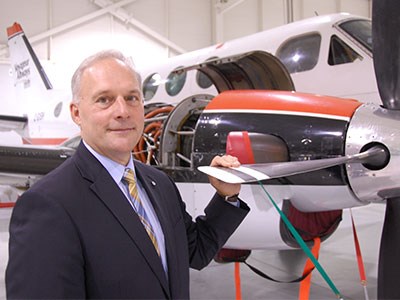George Burton glances around the 17,000 square feet of hangar at Canadore College’s Aviation Campus, stuffed with helicopters and turboprop aircraft, and predicts big things are coming over the horizon in the next five years.
Since arriving back at his alma mater to take the job as president of the North Bay college in 2010, Burton has been keen to drive business to the campus at Jack Garland Airport.
Having a world-class 87,000-square-foot training facility at his disposal to showcase to industry is a big plus.
“Simple philosophy: healthy community, healthy college. You can’t have a health community without economic development,” said Burton. “We’re not unique in that respect. Every college plays a role in economic development, we just happen to be a little more active than others.”
Canadore has a rich 41-year legacy as a world leader in an aircraft maintenance and avionics structure with 3,100 highly sought-after graduates produced in that span.
The college has an ambitious two-phase, 8,000-square-foot expansion plan, as part of its Aviation Evolution, that’s set to get underway to create an advanced composite and metals area – including a non-destructive testing centre – and an upcoming hangar expansion to accommodate jet aircraft arriving shortly.
“Like the industry, we’re changing rapidly,” said Burton.
A new slate of programming will be introduced in aviation management and advanced composites in 2015, including a hybrid program allowing students to combine two or more disciplines, such as avionics with aircraft maintenance, or avionics and structures.
Beyond the physical expansion and programs, there’s an evolution toward introducing more technology to the classroom, labs, and hangar in the next few years, said Burton.
“Smart fuselages” will be talking to students through mobile devices, classrooms will feature fully-simulated engine trainers, and the majority of the repair troubleshooting will be done in the lab.
There will be a significant changeover in the hangar fleet with more mid-sized aircraft and unmanned aerial vehicles (UAVs) the size of a thumb.
UAVs, or drones, have created a popular buzz for their use in everything from military applications, to the oil and gas fields, forestry, mining, even real estate and wedding photography.
Canadore intended to launch a UAV technicians program last year, but it’s been postponed until next year.
“The delay for us has been the UAV discipline has been developing so quickly,” said Burton. “We’re working with industry (on) what is the right type of graduate profile that they require (and) the right technical background. We think we have that nailed down with some major players in the industry.”
Canadore took a great leap forward this year with news that a European satellite company, Swiss Space Systems (S3), was arriving on campus to develop a pioneering new system that delivers small satellites into orbit.
After meeting the Payerne-based company’s principals at an Ottawa aerospace conference, Burton and the college sold them on Canadore’s expertise in avionics and structures, a fully-serviced aerospace industrial park nearby, the airport’s 10,000-foot runway, and the wide-open air space.
S3 has designed the concept for an unmanned, reusable space shuttle – that launches at high altitude off the back of an airliner – to release small satellites into orbit.
In late October, S3’s engineers will be in North Bay testing the instrumentation in preparation for more advanced testing next year when a small-scale shuttle will be flown out of the airport.
Whether the company establishes a permanent presence remains to be seen, but Burton would like to see North Bay become a payload launch site.
“It’s been an exciting space for us to be in – no pun intended – but if you look at nanosatellites, that’s probably the fastest growing spectrum within the whole satellite array.”
Since the arrival of Bombardier water bomber assembly plant in the late 1990s, North Bay has been aggressive in promoting and chasing down aviation-related opportunities.
Five years ago, the city hotly pursued the Dornier Seaplane Company of Florida and its plans for a new assembly plant, a bid that fell short when the Quebec government stepped up with massive subsidies to land the plant for Montreal.
“We haven’t stopped pursuing those opportunities,” said Burton, “but it’s a global business, it’s highly competitive and the incentives to locate aerospace in a community are very high because it’s a high-tech and very clean industry.”
Burton said the city has done its part to create a business-friendly environment, but the provincial and federal governments can always do more to promote investment.
“Speed wins in this arena. Whoever brings forth the best business case to these companies, wins.”
He likes the idea of a tax credit system for companies that partner and make use of educational institutions. That would be relatively painless for governments to do and would address the region’s lack of access to capital.
Last fall, North Bay MP Jay Aspin and Canadore organized and hosted an aerospace forum attended by some major Canadian and international players. For some, it was their first exposure to North Bay.
What will eventually transpire isn’t yet known, said Burton, but having federal Industry Minister James Moore on hand sent a strong message that Ottawa was serious about attracting aerospace investment for the North.
And though it make take time before more established anchor players show up on campus, Burton said he’s “quite confident” a couple more startup companies are likely to arrive within the next two years.




